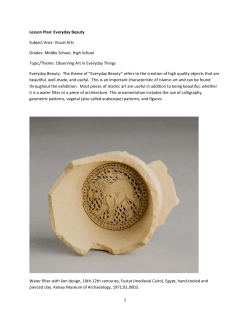
Traditional processing - E
Name: People have been processing natural, raw material into useful products for many years. We have learnt about how some materials are processed in an industrial setting. In a rural / traditional setting, materials are processed into various products as well. We will learn about the processing of clay pots, bricks, hats, mats and thatched roofs. Clay pots Clay is a type of soil with small particles that holds water well and can be made into a ball or sausage easily when mixed with right amount of water. Clay can be molded into various shapes, including clay pots. Traditionally, clay pots are made from clay soil and water. They are molded by hand, dried and then ‘fired’. A fire of wood and cow-dung is made around the dried clay pot. The pot gets very hot and then it is left to cool down. Activity 1: Make a mini-clay pot You will receive a small ball of clay. Using the pictures below to help you, mold the clay into a little pot. Bricks When we learnt about combining materials, we learnt about bricks made in a rural setting. Traditionally, bricks were made from clay soil, animal (cow) dung and straw or grass. These materials were mixed together, molded into bricks and then dried in the Sun. These are used to build different structures such as walls, houses, and so forth. © e-classroom 2015 www.e-classroom.co.za Grade 5 Natural Science Term 2 : Matter and materials; processing materials-traditional processing GRADE 5 Traditional processing GRADE 5 These items are made mostly from grass and reeds. Thatch, as you learnt about in Grade 4, is bundles of grass cut to certain length that is tied to the beams/poles of the Xhosa rondavel huts, using grass ropes. The bundles of grass are tied down from the bottom of the roof to the top, layer upon layer, to make sure it is waterproof. Grass or reeds are also used to weave items like baskets, hats and mats. The grass or reeds are woven or plaited and may be stitched together to make the item. Weaving is a method used to strengthen materials. The fabrics that make our clothes are woven together to make them stronger and more durable. Plaiting is another way to strengthen materials. Three strands are used; they are tied together and then put one over the other, to form a plait. Plaiting a three ply braid rope Activity 1: Weave a mini-mat Materials: Plastic shopping bags, one black dustbin bag, piece of thick cardboard, scissors. What to do: 1. Cut the cardboard into a square (10cm x 10cm). Cut an equal number of notches on the left side and the right side of the cardboard square. This is your cardboard loom. © e-classroom 2015 www.e-classroom.co.za Grade 5 Natural Science Term 2 : Matter and materials; processing materials- traditional processing Baskets, hats, mats and thatch 3. Tie the black bin bag strips together. Tie one end of the long strip to the corner of the loom. Weave the long strip around the notches of the loom, then tie the strip to the last notch. 4. Tie the plastic shopping bag strips together. Tie this strip to the loom as well. Weave the strip through the black strips, over and under. 5. Keep doing this until you have woven a mat on the cardboard loom. 6. To end off the mat, start on one end of the loom, cut the black strip at the notch and tie the two ends together. Repeat until all the loose ends have been tied up and you have a little mat. (This project was taken from http://www.thriftyfun.com/tf75086695.tip.html) © e-classroom 2015 www.e-classroom.co.za Grade 5 Natural Science Term 2 : Matter and materials; processing materials-traditional processing GRADE 5 2. Cut open the black dustbin bag and the plastic shopping bags. Cut them into strips of about 5cm wide.
© Copyright 2025













